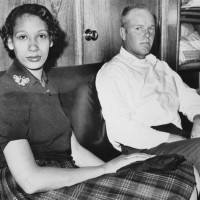Ever since the Bill of Rights was ratified in 1791, the U.S. Supreme Court has been hearing legal cases of all kinds, but increasingly ones nibbling at the edges of marital law have become a regular consideration. Do we see how social science’s understanding of deviance is at work to define marriage? In Part 1, we discussed how deviance from established community values serves to challenge, form, and codify limits of what a community considers acceptable behavior.
The same issues addressed by Exodus, Leviticus, and Deuteronomy thousands of years ago have resurfaced as inheritance, divorce, polygamy, illegitimacy, privacy rights in marriage, child support, financial dependence, and now also same-sex concerns.
6. Enter Vatican II–the sixth watershed moment that happened between 1962 and 1965, critical years in U.S. social upheaval. 
The Second Vatican Council modified the Roman Catholic position on marriage in several significant ways.
- First, the term contract was modified to the term covenant with respect to marriage.
- But also, it elevated mutual love to the same status as the begetting of children in considering purposes for any marriage between a husband and a wife.
- Third, its theology of marriage aligned consistently with the assertions by contemporary society that, according to McBrien’s Catholicism, this was “the first age in which people marry and remain in marriage because they love one another.”
- The term christifideles emphasized that marriage would not be just a union between baptized Christians, but between faithful ones. One’s discipleship in Christ was essential to the union.
- The idea of consummation of marriage extended beyond mere biological concerns to incorporate the kind of mutual love which was at the very core of the sacramental understanding.
- And finally, in matrimony, Christian spouses would experience the mystery of the kind of love between Christ and the Church.
As may already be obvious, elevating mutual love and considering it to be part of the consummation of a marriage meant that the longstanding purpose of legitimate child-bearing did not stand alone, but held a shared position among the purposes of marriage. Attempting to bridge with social concerns about having fulfilling marriages apart from child-bearing, the Catholic Church still tried to anchor the sacramental aspect of Catholic marriage to Christ, the Church institution, and Christian fidelity. The begetting of children, while not devalued itself, took a side role to mutual love. McBrien quotes n.50, saying,
Hence, while not making the other ends of marriage of less value, the true practice of conjugal love, and the whole nature of family life resulting from it, tend to dispose the spouses to cooperate courageously with the love of the Creator and Savior who through them day by day expands and enriches His own family.”
At the same time as theology from Vatican II began to be integrated into American culture, the Courts were making decisions of their own. For two decades after Cantwell vs. Connecticut (1940), free exercise of religion would come before the Supreme Court. In Cantwell vs. Connecticut, the Court had “cordoned off areas of religion that government could not regulate unless they were clearly criminal: religious beliefs, worship, and assembly. Regulation of other religious conduct was ‘permissible’ so long as it as by ‘general and non-discriminatory legislation’ and did not ‘unduly infringe’ upon this exercise” (Witte, Religion and the American Constitutional Experiment).
Regulating marriage was one of the responsibilities that continued to reside with the states according to the Tenth Amendment. However, the Court increasingly faced questions related to each state’s rights in light of the Fourteenth Amendment’s Due Process Clause. In 1965, Griswold vs. Connecticut provided the Court with an opportunity for controversy as “the Court majority ‘created by finding’ in the Constitution’s ‘penumbras and emanations’ the right of marital privacy…[and] led to other major decisions that impacted the very essence of the marital relationship” (Witte).
 So in 1967, the Supreme Court settled another marital issue, that of interracial marriage in Loving vs. Virginia. Chief Justice Warren wrote,
So in 1967, the Supreme Court settled another marital issue, that of interracial marriage in Loving vs. Virginia. Chief Justice Warren wrote,
The freedom to marry has long been recognized as one of the vital personal rights essential to the orderly pursuit of happiness by free men…Under our Constitution, the freedom to marry or not marry, a person of another race resides with the individual and cannot be infringed by the state.”
While interracial marriages were controversial for their day and deserving of legal review, this of course applied to heterosexual marriage. According to Howard Ball, “the traditional heterosexual marital relationship, then and now, was considered a fundamental liberty interest protected from most state action by the Due Process Clause.” The U.S. Supreme Court has referred to this right in addressing issues (such as procreation, raising children, and family relationships, or ones that hinge more directly upon religious traditions, such as contraception).
According to Witte’s 2000 book, Religion and the American Constitutional Experiment, “The incorporation of the First Amendment religion clauses into the Fourteenth Amendment due process clause shifted final authority over the American experiment from the states to the United States Supreme Court…In the past 60 years, the court has issued more than 150 decisions on religious liberty–more than 100 of them applying the First Amendment to state and local governments.”
It shouldn’t surprise us that the Civil Rights Movement and the Feminist Movement of the 1960s and 1970s impacted American culture, and the Courts would be asked to hear new types of cases on complicated issues of faith and culture. Today, the press of social concern regarding the definition of marriage is significantly in the area of civil unions and how to adjudicate First Amendment and Due Process concerns as well as state obligations under the Full Faith and Credit Clause.
 Therefore the Defense of Marriage Act (DOMA), signed into law in 1996, has been on the forefront of recent marriage discussion in our present culture, largely because marriage law varies from state-to-state. The Full Faith and Credit Clause of the U.S. Constitution provides for unity in our country by insisting that states recognize legislative acts, public records, and judicial decisions of the other states.
Therefore the Defense of Marriage Act (DOMA), signed into law in 1996, has been on the forefront of recent marriage discussion in our present culture, largely because marriage law varies from state-to-state. The Full Faith and Credit Clause of the U.S. Constitution provides for unity in our country by insisting that states recognize legislative acts, public records, and judicial decisions of the other states.
According to the New York Times (6/10/2012) “The Republican brief says the statute ‘merely reaffirmed what Congress has always meant’ when it refers to marriage: ‘a traditional male-female couple.’ The federal trial court in California explained, however, that ‘tradition, standing alone, does not provide a rational basis for the law.’”
Tradition spanning at least four thousand years of legal precedent is hardly standing alone.
Since the days of Hammurabi and Moses (and Confucius, too, by the way), we’ve seen the definition of marriage undergo a major change–albeit incrementally–from:
- a joining of one man and one woman, their production of offspring resulting in a positive civilizing influence; and biblically by God, for one man and one woman to be “one flesh” in order to be fertile and multiply God’s image on the earth;
- to arranged common law marriages as a sacred bond of God, for community and individual social benefit by producing children;
- to the individualism of mutually consenting heterosexual partners in marriage (still considered a sacred union with family stability and legitimate children);
- then, brought in and out of the Church along with its religious definition as people refused to honor their vows to each other or their responsibilities to their children;
- to an individual, personal, and mutual consent to love as redefined by the Church;
- to a legal entity that must be registered as a function of government;
- and finally into our court system as legal scholars are being asked to decide who may legally marry.
To ask “Who is legally allowed to marry?” is asking the wrong question, though. The law has become a complicated mess—entangled by precedents, judicial activism, and tax code concerns.
When we ask the right question, “What was the original purpose of marriage?,” we see that marriage is a sacred bond. For Christians and Jews, marriage is joining of one man and one woman by God and making them “one flesh.” This cherished religious value remains the core of an institution which has survived the millennia.
Let’s consider this: the legal code was never developed to deal with defining marriage. Marriage came first. The legal code was developed to deal with sin.
 We’ve gone from an enduring institution reflecting God’s ideal and original design of image bearing by God’s people to an ephemeral here-today-gone-tomorrow Kardashian ideal fashioned after American popular culture. Should marriage–something so critical to the survival and civilizing of society–bear the image of something so transient as politics or celebrity?
We’ve gone from an enduring institution reflecting God’s ideal and original design of image bearing by God’s people to an ephemeral here-today-gone-tomorrow Kardashian ideal fashioned after American popular culture. Should marriage–something so critical to the survival and civilizing of society–bear the image of something so transient as politics or celebrity?
If marriage is a sacred institution of God, legitimized by government as authorities have stated throughout American history, ought the law ever have the final say in this tug of war between church and state?
Perhaps given the ongoing legal attempts to shift the definition of marriage, it’s time to reclaim a cherished American principle—the separation of church and state—and insist that it mean something when it comes to marriage (a sacred institution of God) and any government’s reach to define marriage as a merely civil union and infringe on religious liberty.
Christians have an equal right to religious views, so for us the original purpose of marriage remains the same as it was in the beginning. What God has joined together, let man not separate.
4 Comments
Barbara, thanks for this insightful and far-reaching essay. very very informative. what were some of the sources that got you thinking about this?
I’m not a prophet, but I have been greatly concerned about the path we are headed on in the US as Christians sit on the sidelines with our hands in our pockets. Afraid of being called “intolerant” or stupid or whatever, we’ve retreated from asking hard theological and legal questions about where the US is going with issues such as (recently) gay marriage, contraception, religious freedom, abortion, health care, etc. I began my Wrong Questions series with Patriarchy, then Rights and Freedom, followed by Marriage and my next article will be an in-depth look at Asking the Wrong Questions about Homosexuality.
All one has to do is listen to the news to see that we are approaching a point of no return. If we don’t change direction, we’re likely to end up where we’re headed.
Oh, and not to leave out the obvious answer to all questions: Jesus! 🙂
God has had me researching marriage for over a month with a stack of books a mile high. Finally, the promptings of the Holy Spirit were starting to keep me awake at night so I pushed the “publish” button. 😀
And one more thought…most of the books I’ve looked at were dealing with the development of the law and religious freedom from a legal perspective in the West (US specifically). Being more of a theology person, I couldn’t help but see these in light of the development of religion.
Don’t you find it interesting that if redefining marriage to include the GLBT relationships was a matter of true civil/human rights, they’d be pursuing this classification worldwide and not just in the Judeo-Christian world? If it’s a human right, why aren’t they pursuing civil marriages for homosexuals in countries that have Islamic ties?